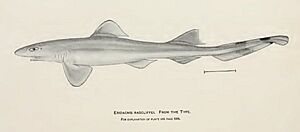Proscylliidae facts for kids
Quick facts for kids Finback catsharks |
|
|---|---|
 |
|
| Eridacnis radcliffei | |
| Scientific classification |
|
| Kingdom: | Animalia |
| Phylum: | Chordata |
| Class: | Chondrichthyes |
| Order: | Carcharhiniformes |
| Family: | Proscylliidae Compagno, 1984 |
| Genera | |
|
See text |
|
The finback catsharks are a group of small sharks. They belong to a family called Proscylliidae. You can find these sharks in warm oceans all over the world. They are often very common in tropical areas. Most finback catsharks are less than 1 meter (about 3 feet) long. They are slow swimmers and hunt for small fish and tiny ocean creatures. Some finback catsharks give birth to live young. But most lay eggs. These eggs have almost fully developed babies inside. The egg cases are often called "mermaid's purses" because of their unique look. Each species has its own special egg case design!
Contents
Discovering Finback Catsharks
Finback catsharks come in different types. Scientists group them into different genera (like big families) and then into species (specific types). Let's meet some of them!
Types of Finback Catsharks
Genus Proscyllium: Graceful and Magnificent Sharks
- Graceful Catshark (Proscyllium habereri): This shark was first found in 1901.
- Proscyllium venustum: You can find this shark in cooler waters, mainly near Japan in the Northwest Pacific. These sharks lay eggs in pairs. The baby sharks inside the eggs get all their food from a yolk, just like a bird's egg. They are not dangerous to humans.
- Magnificent Catshark (Proscyllium magnificum): This is a newer discovery in the finback catshark family. Not much is known about it yet! It has a tan color with dark spots and patches. Its body is slim and firm. These sharks can grow to be at least 450 millimeters (about 1.5 feet) long. They have been seen in warm waters off the coast of Myanmar, in the eastern Indian Ocean.
Genus Eridacnis: Small and Deep-Sea Dwellers
- Pygmy Ribbontail Catshark (Eridacnis radcliffei): This is one of the smallest sharks in its group! It grows to only about 257 millimeters (around 10 inches) long. It lives in the waters around the Philippines and in the Indo-West Pacific Ocean. You can find them near muddy seabeds on the edges of continents. People don't usually fish for them. However, they can get caught by accident in nets used to catch shrimp, which is a main food source for them. They are harmless to people.
- Cuban Ribbontail Catshark (Eridacnis barbouri): This shark lives in deep waters along the upper edges of continents. It is found in the western central Atlantic Ocean. It eats small fish, crabs, and squid. These sharks give birth to two live young at a time. The babies are over 10 centimeters (about 4 inches) long when born. They are also harmless to humans.
- African Ribbontail Catshark (Eridacnis sinuans): This shark is grey-brown. It lives in the western Indian Ocean, specifically near South Africa, Mozambique, and Tanzania. Like the Cuban ribbontail, it prefers deep water on the upper continental shelf. It eats small fish, crustaceans, and squid. They also give birth to two live young. The babies are about 15 to 17 centimeters (6-7 inches) long at birth. This species is not harmful to humans.
Genus Ctenacis: The Harlequin Catshark
- Harlequin Catshark (Ctenacis fehlmanni): This shark has some special features! It has a large mouth, tiny teeth, and a big throat with special structures called gill raker papillae. These features make it unique among finback catsharks. They live in warm waters off the coast of Somalia, in the western Indian Ocean. They hunt for very small ocean creatures. These sharks lay eggs in pairs. The embryos inside the eggs feed only on yolk.
Where Do They Live?
Finback catsharks live mostly along the edges of continents, called continental shelves. They are found in many places around the world. Some of the main locations where they have been seen include Japan, Myanmar, the Philippines, South Africa, Mozambique, Tanzania, and Somalia.
The Life Cycle of Finback Catsharks
How Finback Catsharks Reproduce
Finback catsharks reproduce in two main ways. Some species are oviparous. This means they lay eggs on the seafloor. These eggs are often attached to something solid. The eggs have a tough, leathery shell for protection. The baby shark inside grows by eating the yolk in the egg. Other species are ovoviviparous. These sharks keep their eggs inside their bodies until the babies are ready to hatch and be born as live young.
Finback Catsharks and People
People do not usually fish for finback catsharks for food or other uses. These sharks are not considered endangered or threatened. However, they can sometimes be caught by accident in fishing nets. This is called "bycatch." The shrimping industry, which uses nets to catch shrimp, has had the biggest impact on these small sharks.

